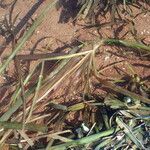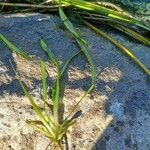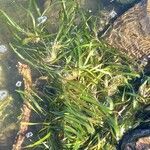Dioecious, perennial or occasionally annual. Stems short, contracted, mostly developing stolons or runners. Foliage leaves arranged in 2 rows, sometimes spiralised, narrowly strap-shaped, up to 2 m or more long, the margin usually with unicellular spines from base to tip. Inflorescences axillary; spathe of 2 united bracts; the male borne on up to 7 cm long stalks, ovoid, ± 5 mm long; female spathes borne on up to 1 m long stalks, ± cylindrical. Male flowers very small and very numerous (± 50) in spathes, shed as buds and opening on the water surface; sepals unequal (2 large, 1 smaller), ± 0.5 mm long, becoming reflexed at anthesis; petal rudimentary or absent; staminode 1 or absent; stamens 2, free, divergent, ± 0.5 mm long, without hairs at base. Female flowers solitary and sessile in long stalked (up to 1 m long) spathes, opening and floating on the surface at maturity; with an incision deepest between the matching stigmatic lobes (opposite the petal rudiment); sepals 3, ovate, up to 3 mm long; petals 3, narrowly ovate, ± 0.5 mm long; staminodes 3, alternating with the petals. Ovary of 3 carpels; styles 3, ± 2 mm long, each with 2 flattened papillose lobes, each fringed along the margin. Fruit an irregularly dehiscing capsule. Seeds numerous, ellipsoidal, 1.3-2 mm long. Leaves totally submerged, grows in still and flowing water (up to ± 1 m/sec); often very common and sometimes locally dominant. Pollinated on the water surface, with mobile male flowers on the water surface caught by floating but attached female flowers. Disseminules are seeds and vegetative fragments.
More
A plant which grows under water. The leaves are like ribbons. They grow in rings. They are 20-80 cm long by 0.5-1.3 cm wide. The leaf veins run parallel along the leaf. There are small dents near the leaf tip. Male and female plants are separate. The flower stalk forms spirals. The male flowers break off and swim to the surface to release their pollen. The spiral flower stalk contracts and the seeds ripen below water level. It has many different growth forms.
V. spiralis L. differs from V. gigantea by the relatively narrower entire leaves (to 1 cm), with always only 5 nerves; female flower mostly smaller than that of V. gigantea; spathe covering only the base of the ovary; acute sepals; fringed styles; absence of blackish and brown stripes on leaves, female spathe, and sepals (in V. spiralis sometimes black or brown dots)




